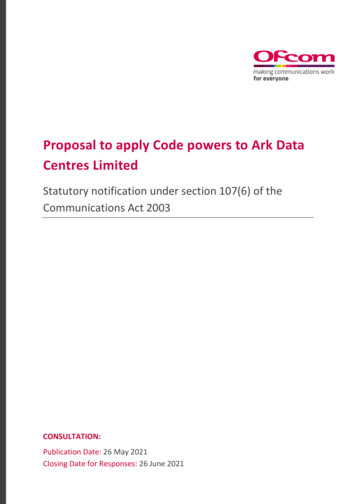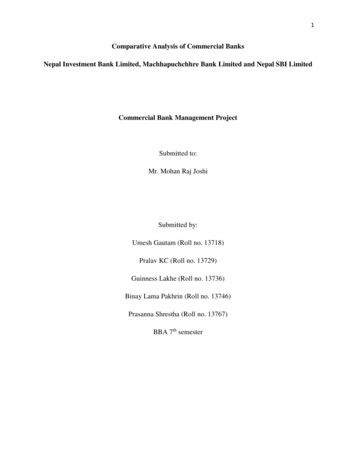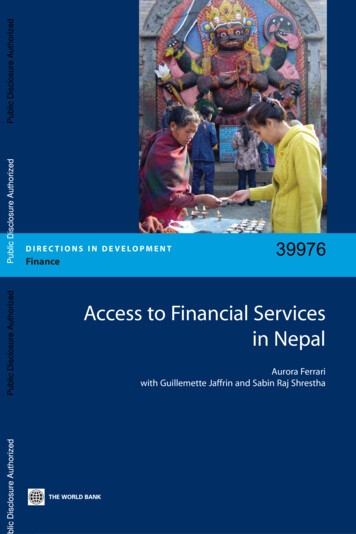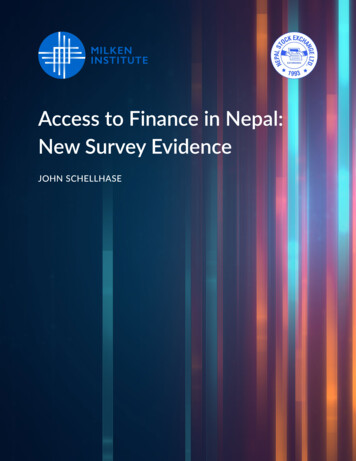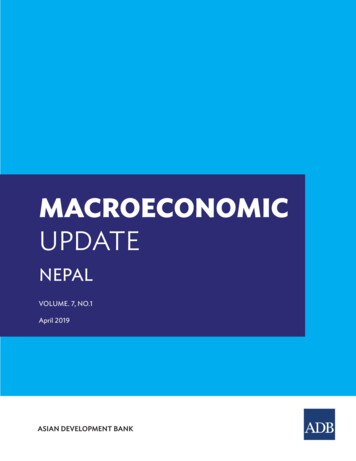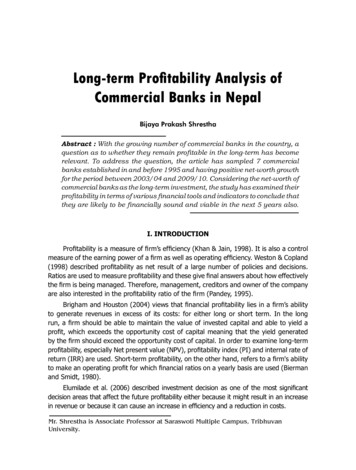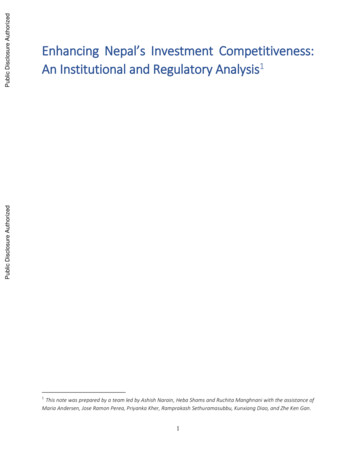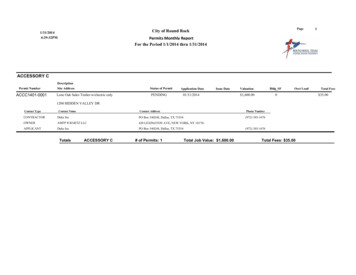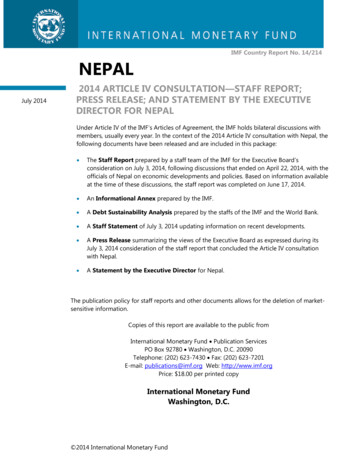
Transcription
IMF Country Report No. 14/214NEPALJuly 20142014 ARTICLE IV CONSULTATION—STAFF REPORT;PRESS RELEASE; AND STATEMENT BY THE EXECUTIVEDIRECTOR FOR NEPALUnder Article IV of the IMF’s Articles of Agreement, the IMF holds bilateral discussions withmembers, usually every year. In the context of the 2014 Article IV consultation with Nepal, thefollowing documents have been released and are included in this package: The Staff Report prepared by a staff team of the IMF for the Executive Board’sconsideration on July 3, 2014, following discussions that ended on April 22, 2014, with theofficials of Nepal on economic developments and policies. Based on information availableat the time of these discussions, the staff report was completed on June 17, 2014. An Informational Annex prepared by the IMF. A Debt Sustainability Analysis prepared by the staffs of the IMF and the World Bank. A Staff Statement of July 3, 2014 updating information on recent developments. A Press Release summarizing the views of the Executive Board as expressed during itsJuly 3, 2014 consideration of the staff report that concluded the Article IV consultationwith Nepal. A Statement by the Executive Director for Nepal.The publication policy for staff reports and other documents allows for the deletion of marketsensitive information.Copies of this report are available to the public fromInternational Monetary Fund Publication ServicesPO Box 92780 Washington, D.C. 20090Telephone: (202) 623-7430 Fax: (202) 623-7201E-mail: publications@imf.org Web: http://www.imf.orgPrice: 18.00 per printed copyInternational Monetary FundWashington, D.C. 2014 International Monetary Fund
NEPALSTAFF REPORT FOR THE 2014 ARTICLE IV CONSULTATIONJune 17, 2014KEY ISSUESContext: Successful elections for a new Constituent Assembly and formation of a newgovernment have stabilized the political situation.Macroeconomic situation and outlook: Nepal’s macroeconomic situation remainsbroadly favorable. Growth is projected to recover in 2013/14 owing to good monsoons,robust growth in services, and increased public spending. Inflation is moderating, in linewith developments in India. High remittance inflows are supporting a strong externalposition, as well as high reserve money growth. Risks to the outlook are slightly tilted tothe downside, involving slower-than-expected growth in countries hosting Nepaliworkers and domestic financial sector risks.Medium term prospects: While remittances are expected to continue to support theexternal position, the outlook for growth depends on improving the environment forprivate investment. This requires a decisive boost in public capital spending, andstructural reforms in key areas.Financial sector: Despite progress, significant vulnerabilities remain. The recentassessment under the FSAP, Nepal’s first, raised concerns about asset quality andinterconnectedness, as well as financial sector infrastructure—including the legalframework—and supervision and crisis preparedness. At the same time, a largelyunsupervised cooperatives sector is growing rapidly.Key policy recommendations: Monetary policy should aim at controlling the volatilityand level of excess reserves in the financial system, implying a modest tightening ofmonetary conditions. The exchange rate peg to the Indian rupee provides a usefulnominal anchor for the economy, and the real exchange rate is broadly in line withfundamentals. Capital spending needs to be boosted to provide key infrastructure, andreforms implemented to support private investment, which will help generate sustainedeconomic growth and employment opportunities. In the financial sector, further reformsto bolster regulation and supervision, and improve financial infrastructure are needed toreduce risk and increase access to finance.
NEPALApproved ByPaul Cashin and RanilSalgadoDiscussions took place in Kathmandu during April 9-22, 2014. Thestaff team comprised Mr. Pitt (head), Messrs. Ojima and Mohommad(all APD), and Mr. Mathieu (MCM), and was assisted by Mr. Richardson(Senior Resident Representative for India/Nepal). Messrs. Ghaffour andKharel (both OED) also participated. May Inoue, Michael Dalesio, andQianqian Zhang (all APD) assisted in the preparation of this report.CONTENTSINTRODUCTION 3RECENT ECONOMIC DEVELOPMENTS, OUTLOOK, AND RISKS 3A. Recent Developments 3B. Outlook 4POLICY DISCUSSIONS 5A. Exchange Rate Policy 5B. Monetary Policy 7C. Financial Sector Policies 9D. Fiscal Policy 12E. Boosting Sustainable and Inclusive Growth 13OTHER ISSUES 14STAFF APPRAISAL 14BOXES1. Spillovers from India 52. Exchange Rate Assessment 63. Inflation Determinants 84. Key FSAP Recommendations 11FIGURES1. Recent Developments 162. Monetary and Financial Developments 173. Business Environment and Governance 184. Inclusive Growth 19TABLES1. Selected Economic Indicators, 2010/11–2014/15 202. Summary of Government Operations, 2010/11–2014/15 213. Monetary Indicators, 2010/11–2014/15 224. Balance of Payments, 2010/11–2018/19 235. Macroeconomic Framework, 2010/11–2018/19 246. Commercial Banks’ FSIs, 2006–2013 257. Millennium Development Goals 26ANNEXI. Risk Assessment Matrix 272INTERNATIONAL MONETARY FUND
NEPALINTRODUCTION1.Political uncertainty has receded after successful elections for a new ConstituentAssembly (CA) in November 2013. The Maoist party—the largest party in the previous CA—lost in a landslide, winning only 14 percent of seats. The two other main parties—NepaliCongress and United Marxist-Leninists (UML)—won 34 percent and 30 percent of the vote,respectively, and are the main partners in the governing coalition. The previous CA, elected inApril 2008, had been dissolved in May 2012, following repeated changes of government andfailure to draft a new constitution.2.Remittances have led to improvements in living standards, but may be weakeningexternal competitiveness. Remittances from an estimated 2.2 million workers abroad (8 percentof the population) are projected to rise to almost 30 percent of GDP in 2013/14, considerablylarger than the 9 percent of GDP in 2000. At the same time, the poverty headcount fell from55 percent in 1995 to 25 percent in 2011. However, remittances may also erode competitiveness,as suggested by rising wages and declining shares of exports and industry in GDP, and weakenthe impulse for policy reforms.RECENT DEVELOPMENTS, OUTLOOK, AND RISKSA. Recent Developments3.The macroeconomic situation remains solid, but growth is low. GDP growth slowedto below 4 percent in 2012/13, largely due to a weather-related weakening in agricultural output,but the delay in passing a full budget also resulted in low capital spending and a fiscal surplus.1Inflation rose to over 10 percent y/y in December 2013 in the wake of the depreciation of theIndian rupee, but moderated to 8.9 percent y/y in March 2014. Growth of remittances rose to17½ percent in the first eight months of 2013/14, partly on account of the depreciation. Thisfueled further build-up of international reserves, which stood at 5.8 billion (8.1 months ofprospective imports) in March. High remittance inflows also drove reserve money growth of30½ percent y/y in March, though private sector credit growth slowed to 15½ percent y/y.Despite efforts to accelerate spending, capital expenditure remained low.4.The authorities have made efforts to implement IMF policy advice, but have beenhampered by political uncertainty. Progress has been made toward consolidating the financialsector, and the Nepal Rastra Bank (NRB) has begun to strengthen supervision, including withtechnical assistance (TA) from the IMF and donors. A full budget was passed on time for 2013/14,the treasury single account (TSA) has been rolled out to all 75 districts, and reforms in revenueadministration are ongoing (with IMF TA). However, monetary policy has remained loose, and1The fiscal year ends in mid-July.INTERNATIONAL MONETARY FUND3
NEPALnon-transparent implicit subsidies to the Nepal Oil Corporation (NOC) and Nepal ElectricityAuthority (NEA) continue.B. Outlook5.The macroeconomic outlook is broadly stable. Output growth is expected to pick upto around 4¾ percent in 2013/14, driven by a recovery in agriculture, strong services, and higherpublic spending. Inflation is projected to moderate further (in line with declining Indian inflation)but remain high, at 8 percent (y/y). The current account surplus is forecast to rise to over4 percent of GDP on account of remittances. Capital spending should accelerate in the lastquarter, in line with previous patterns, contributing to net incurrence of financial liabilitiesprojected at 1¼ percent of GDP. Private sector credit growth is expected to accelerate slightly. In2014/15, growth is projected to increase somewhat as confidence improves, and inflation tomoderate with India’s inflation. The current account surplus is expected to decline, as remittancegrowth slows.6.Medium-term prospects hinge on improving the environment for privateinvestment. While remittances are expected to continue to support the external position, theoutlook for growth will remain modest in the absence of a decisive boost in public capitalspending to crowd in private investment, and structural reforms in the financial sector, andtelecommunications, competition, labor market, and business regulation reforms. Growth isprojected to remain at around 4½ percent in the medium term, with gradual improvements inexecution of the capital expenditure budget supporting activity as remittance growth moderates.The external position is expected to remain strong, with international reserves high.7.Risks to the outlook are somewhat tilted to the downside (Annex 1). With limitedlinks to global financial markets, external risks to the outlook stem mainly from a slower-thanprojected recovery in India (Box 1), or a slowdown in countries that host Nepali workers.Domestic risks arise from the financial sector, especially from the large number of weak smallerbanks and the largely unsupervised cooperatives sector, and from a potential failure to furtherimprove the political climate. On the other hand, a decisive reform push and increase in publicinvestment would likely boost private investment, raising growth beyond baseline projections. Adebt sustainability analysis (DSA) indicates that Nepal is at low risk of debt distress, due toreduced estimates of the cost of a potential banking sector crisis, and the increase in thediscount rate used to assess LICs’ debt burden. This is a significant improvement compared tothe previous DSA, which indicated a moderate risk of debt distress (Appendix 1).Authorities’ Views8.The authorities broadly concurred with the staff’s assessment, but thought thatgrowth could be higher, on account of stronger growth in services. They also pointed totheir plans to accelerate capital spending, and spur credit to productive sectors (especiallyagriculture, hydroelectric power, industry, and tourism). With regard to risks, they emphasized4INTERNATIONAL MONETARY FUND
NEPALthat further improvement of the political climate was a prerequisite for higher private sectorinvestment.Box 1: Spillovers from IndiaNepal has a close economic relationship with India, with theResponses of Output to a Negative GDPShock in Indiaopen border facilitating movement of goods and labor.However, trade and remittance flows do not suggest large0.2spillovers from India to Nepal. While India is Nepal’s largestRemittances from India are estimated to account for only10 percent of total remittances received by Nepal; 90 percent0.0-0.01-0.04-0.03SRI LANKAlimiting the potential impact of a slowdown in Indian demand.0.1PAKISTANtrading partner, exports constitute a small share in Nepal’s GDP,-0.1originate from other destinations, primarily Persian Gulf statesappear to have led to significant cross-border capitalmovement). While econometric evidence suggests that theimpact on Nepal from a shock to India’s growth is the highestamong South Asian peers, the overall effect is modest (Cashinand Raissi, IMF Country Report No. 14/58).-0.21-0.3NEPALfinancial linkages are also limited (the open border does not-0.2BANGLADESHand Ma
Exchange Rate Assessment _6 3. Inflation Determinants _8 4. Key FSAP Recommendations _ 11 . sector, and the Nepal Rastra Bank (NRB) has begun to strengthen supervision, including with technical assistance (TA) from the IMF and donors. A full budget was passed on time for 2013/14, the treasury single account (TSA) has been rolled out to all 75 districts, and reforms in revenue .

